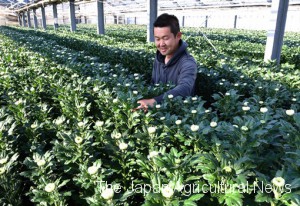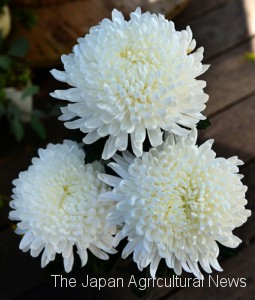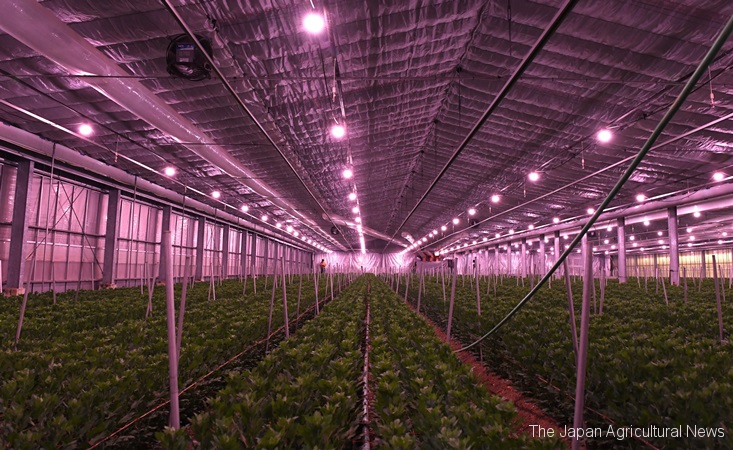
Akabane region in Tahara town, Aichi Prefecture, was illuminated by glowing chrysanthemum greenhouses. The light on the left is a residential area. (in Tahara town, Aichi Prefecture)
AICHI, Nov. 5 – A number of greenhouses are glowing and creating a breathtaking night view in Tahara town, Aichi Prefecture. What creates this most spectacular scenery is lighting in chrysanthemum nurseries set by local farmers. In other words, it’s the latest skills and techniques of farmers that light up one of Japan’s largest chrysanthemum producers.

Ishii checking his chrysanthemums “Sei no Issei,” which are almost ready for shipment. He looks at color and size of buds to decide when to cultivate them.
You can enjoy the magnificent night view from a lookout at the height of approximately 150 meters in the park called Akabane Bunka no Mori. At around 9 p.m., glowing greenhouses appeared in the darkness as the farmers turned on the lights to keep the short-day plant nurseries bright. The greenhouses were lit up until midnight.
Thanks to the warm climate, Tahara city on Atsumi Peninsula is one of Japan’s largest producers of cut chrysanthemums and spray mums. The night-break treatment is one of the techniques adopted by local flower growers. They use lamps to inhibit flowering in the short-day plants to regulate the shipping.
A group of chrysanthemum producers that belongs to an agricultural cooperative in Aichi Prefecture (JA Aichi Minami) has around 750 members and ships approximately 230 million cut chrysanthemums a year in total.

White chrysanthemums in full bloom and ready for shipment. Flowers grown to full bloom in greenhouses are called “Full Bloom Mums”.
Takashi Ishii, vice president of the chrysanthemum producers’ association, currently produces white “Jinba” chrysanthemums whose shipment begins later this month and continues until May next year.
Ishii lights up young chrysanthemums in his greenhouse from 9 p.m. to 2 a.m. every night. When the plants are 60 centimeters tall, he stops the treatment, and in around 50 days, the flowers are ready for the shipment, according to the 46-year-old chrysanthemum grower. “Chrysanthemums are so delicate that they grow differently in different greenhouses even if we apply the same amount of lighting to them,” he said. “I must pay attention to their changes in order to produce high-quality flowers,” he continued.
Chrysanthemum producers in Tahara city introduced the night-break treatment in 1947. At first, they adopted the technique only to the chrysanthemums that flower in autumn, but currently, they use the skill throughout the year.
The use of light-emitting diode (LED) lamps is now standard for their lower electricity consumption compared to incandescent lamps. An increasing number of growers recently use red and pink lights also to control floral bud formation.
Takao Ogawa is a 28-year-old JA worker who handles JA’s flower retail businesses. He said, “Chrysanthemums are great flowers that keep for long time. We are going to make efforts to expand the use of them, for example, for weddings and all other purposes.”


